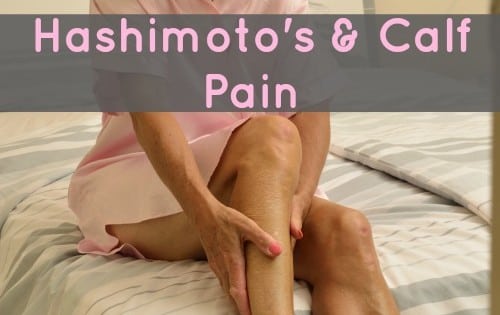Leg cramps, although usually harmless, can be extremely painful. Hashimoto’s and Calf Pain is common, when leg cramps occur at night they interrupt sleep and can leave you feeling exhausted. Cramping is a prolonged contraction of the muscles, most often affecting the feet and calves. Why muscles cramp, or go into spasm, is not always evident.
Hashimoto’s and Calf Pain Causes
The cause may be due to inadequate blood flow to the muscle resulting in a lack of oxygen. Standing for long periods can affect circulation and overtax calf muscles, so can over-exertion, which can also lead to muscle fatigue.
Heavy sweating during exercise can upset mineral balances; your muscles react by cramping. Other possible causes are varicose veins, problems inside the arteries, nervous-system disorders and alcohol or nicotine abuse.
Cramps during the night may result from either daytime exertion or the toes remaining still in a pointed position. Underlying illness should always be ruled out if regular cramping occurs.
In my eBook Hashimoto’s: Finding Joy in the Journey, I shared my experience about intense and excruciating calf pain. The pain would begin almost immediately whenever I took even a short walk. My calves started cramping very soon after my first few steps into the walk. The pain felt like a stiffening/contracting of the muscles to the point that if I took one more step my calves would “break.” That’s the only way I know how to describe it. There were many times I couldn’t make it back home of foot and my husband would have to go back, get the car and pick me up. Although it was only a short distance away, I was too heavy at the time to be carried. The pain of not being able to take a normal walk brought on not only embarrassment and tears, deep down I was filled with a lot of fear.
I was scared something very serious was wrong with me.
Since the pain was triggered by walking and would immediately stop with rest I honestly thought at one point that I had a condition called claudication and so did my doctors. Based on my symptoms they were sure that’s what it was.
I remember thinking “I’m too young for this!”
Claudication is a condition in which cramping pain in the leg is induced by exercise, usually caused by arterial obstruction.
I was tested multiple times with pulse tests, doppler ultrasound and ankle-brachial indexing which were always negative.
It wasn’t until I was diagnosed with Hashimoto’s eight years later and started my healing journey that my “pain when walking” disappeared. Fortunately, I’ve been free of the mystery calf pain ever since. Looking back, I know I had vitamin and mineral deficiencies, especially magnesium and I was consuming inflammatory foods even though at the time I truly thought I was consuming a healthy diet. Also, the eight years of not being diagnosed and treated means my thyroid hormone levels were tanking.
I’ve since learned that it is not uncommon for Hashimoto’s patients to suffer with cramping in the calves and other muscles.
The term myopathy refers to disease of muscle tissue. In a clinical study to review myopathy as symptom of autoimmune thyroid disease, ten patients (5 female and 5 male) all of whom had Hashimoto’s and had reported symptoms of muscle fatigue, weakness, cramps, and pain were studied. Although no apparent muscle tissue disease was present in the study group, the researcher’s did find that “an isolation of muscle tissue disease as the sole manifestation of hypothyroidism” is not rare (Rodolico, et al., 1998). The participants reported a significant improvement and then a disappearance of their muscle-related symptoms after initiating thyroid hormone therapy, specifically levothyroxine. Their final conclusion was that when a patient is experiencing symptoms of muscle pain, fatigue, cramps, weakness, etc., and all other potential causes have been ruled out, it is appropriate to consider a possible connection to their symptoms of muscle pain being thyroid-related and to pursue testing to fully evaluate thyroid function.
There are also several clinical trials to support the use of magnesium for leg muscle comfort by helping to lessen occasional nighttime cramping while also helping with sleep.
What You Can Do:
To relieve the immediate acute pain episode, stretch out the affected calf. To prevent injury, stretch out your muscles before exercise. Drink plenty of water to stay hydrated and if indicated you may need electrolyte packets to replenish lost minerals. Assess your diet to ensure you are getting essential minerals before opting for supplemental electrolyte products.
Generally, massages, Epsom salt or magnesium flake baths and leg wraps help to alleviate cramp pain. In some cases you can relieve and even prevent leg cramps with stretching. Acupressure, antispasmodic and circulation-boosting herbs can also help (see below).
Essential Nutrition & Supplements

Supplements
Electrolytes like magnesium, potassium, and calcium are important for maintaining healthy muscle function. Many patients with Hashimoto’s are deficient or have imbalances in these despite a healthy diet due to issues with absorption. I often recommend magnesium supplements. You you can also use topical magnesium oil and lotion. Ancient Minerals also offers magnesium bath flakes which are a special treat because they’re so luxurious. Many of my clients have reported major improvement and experiencing a lot less muscle pain with the use of this unique Muscle Cramp/Tension Formula. It contains soothing botanicals (lemon balm, passion flower & chamomile) to promote overall relaxation PLUS the correct ratios of calcium, magnesium, potassium. It also contains vitamin C.
Medicinal Herbs

Crampbark (viburnum), kava kava and valerian are all antispasmodic herbs that can help relax cramped muscle. Take one dropperful of a tincture of any of these herbs every 1-2 hours. Decrease the amount as muscles begin to relax. For immediate relief, lengthen the calf muscle by flexing your foot. At the same time, massage the cramped calf and then do a few gentle leg stretches. Walking can also stretch out your leg muscles; however, if walking exacerbates your pain, STOP and consult your physician. Testing is indicated in this situation to rule out any vascular or cardiac-related issues.
Complimentary & Alternative Modalities
Rose-petal Rub
Rubbing the calves with an oily extract of rose petals is especially good for nighttime cramps. Fill a canning jar three-quarters full with rose petals. Pour olive oil into the jar to a level of 1-2 inches above the petals. Let the mixture stand for 3-4 weeks, shaking it every day. Strain through a cloth. Apply the oil into your muscles at bedtime. Store the oil in a dark bottle in a cool place. You may also use a high quality, therapeutic-grade rose essential oil instead if you prefer.
Heated Calf Wrap
A hot wrap increases blood flow while relaxing the muscles. Dip a soft towel halfway into hot water, wring it out and fold in half. Wrap the wet half around the calf so the dry half is on top. Fasten the wrap in place with a wool scarf. Leave the wrap on for 20 minutes. Repeat if necessary. You can also use hot water with Epsom salt.
Acupressure for Relief
Carefully press your thumbs or index finger in the middle of your calf muscle. Maintain the pressure for 2-3 minutes until the cramp subsides.
Massaging with Liniment
After the calf muscles have been under strain, try massaging them with witch hazel or alcohol-based liniment. Knead the muscle over its entire length, or massage from the ankle upward.
Recipe:
(Adapted from WellnessMama.com)
- 1 cup witch hazel (or rubbing alcohol)
- 1/2 teaspoon cayenne pepper
- 1 teaspoon menthol crystals
- 1 tablespoon each dried St. Johns Wort
- 2 tablespoons each of comfrey flowers, lavendar flowers, arnica flowers, and peppermint leaf
- 1 teaspoon ginger essential oil
For fresh herbs Mountain Rose Herbs is a great resource.
Instructions
- Place all herbs and menthol crystals in a pint size glass Mason jar.
- Add the witch hazel (or rubbing alcohol) and make sure all herbs are covered.
- Allow the mixture to sit for 4-8 weeks.
- Strain the herbs and store the liniment in a spray bottle or dark glass bottle. Add essential oil of ginger.
- Apply to muscles with a cotton ball.
Soaking in Epsom Salts
Dissolve 3-4 cups of Epsom salts or magnesium flakes in a hot bath; soak for 20-30 minutes. Epsom salts are high in magnesium, which soothes muscles and the bath’s heat stimulates blood flow.
Extra Tips
- According to traditional Eastern medicine, meat and salt cause muscles to cramp. If you suffer from leg cramps, try avoiding or eating less refined table salt and meat, especially sausage. Use sea salt and herbs in place of table salt – you may find them more flavorful.
- Make sure you consult with your physician about muscle cramps and get tested. Insist upon tests for claudication if you experience pain in the calves upon exertion especially if it subsides as soon as you stop the activity. Let him or her know about any self-care remedies you’ve tried and what did or did not help.
- Request a full thyroid panel. I suggest to all my Hashimoto’s clients to have essential thyroid markers checked every 4 months (3 times per year). If your doctor doesn’t want to order the tests, you can self-order your own in between doctor visits (unless you live in NY, MD, NJ or RI) and it’s very affordable. DirectLabs is now contracting with Quest Diagnostics so they offer even more convenient locations to have your blood drawn. You will want to at least check Free T3, Free T4, Thyroperoxidase (TPO) antibodies, anti-Thyroglobulin antibodies, Reverse T3 and TSH.
- Get your RBC magnesium level checked. The test you need to request is the Red Blood Cell (RBC) Magnesium blood test. If it doesn’t say RBC magnesium OR Magnesium, RBC (depending on the lab) it’s not the test you want. A RBC magnesium blood test measures how much magnesium is inside the cell whereas a basic magnesium test measures how much is in the bloodstream. Blood levels can actually be higher because as the magnesium inside heart cells goes down, the body tries to compensate. This means you may actually be deficient in magnesium even though your blood levels show you’re in the normal range. Sounds sort of like what we go through with thyroid labs doesn’t it? DirectLabs offers the Magnesium RBC test for only $59 and it’s good information to know.
References:
- Grisanti, R. (n.d.). Magnesium: The Fact That Can Kill You. Retrieved February 18, 2016, from http://www.functionalmedicineuniversity.com/public/882.cfm
- Rodolico, C., Toscano, A., Benvenga, S., Mazzeo, A., Bartolone, S., Bartolone, L., . . . Vita, G. (1998). Myopathy as the Persistently Isolated Symptomatology of Primary Autoimmune Hypothyroidism. Thyroid, 8(11), 1033-1038. Retrieved February 18, 2016, from http://www.ncbi.nlm.nih.gov/pubme/?querykey=4%26dbase=pubmed%26querytype=eSearch%26
The information presented has not been evaluated by the Food and Drug Administration and the information provided is not intended to diagnose, treat, cure, or prevent any disease. The following information serves as guidelines to assist the individual in using preventative health knowledge effectively for improving overall health.
1. These guidelines should NOT substitute for sound clinical judgment or conventional therapies that may be needed for a particular individual.
2. Before starting on any product read carefully and consider all directions and warnings on the product label.
3. Before making any lifestyle changes please consult with your physician.
4. The guidelines offered are intended to assist the individual in achieving optimal health and well-being.
5. Refer to the Terms & Conditions including our affiliate disclaimer for this website for additional information.




